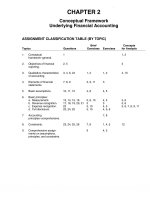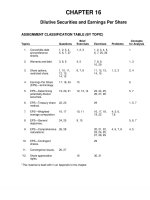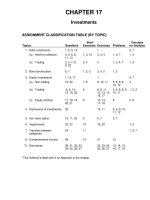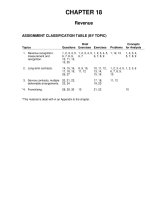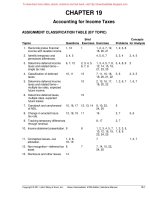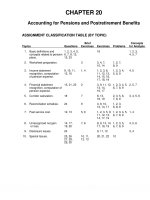Intermediate accounting IFRS 3rd ch02
Bạn đang xem bản rút gọn của tài liệu. Xem và tải ngay bản đầy đủ của tài liệu tại đây (1.33 MB, 55 trang )
Prepared by
Coby Harmon
University of California, Santa Barbara
Westmont College
2-1
Conceptual Framework
for Financial Reporting
CHAPTER 2
LEARNING
LEARNINGOBJECTIVES
OBJECTIVES
After studying this chapter, you should be able to:
1.
2.
2-2
Describe the usefulness of a
conceptual framework and the
objective of financial reporting.
Identify the qualitative
characteristics of accounting
information and the basic
elements of financial
statements.
3.
Review the basic
assumptions of accounting.
4.
Explain the application of the
basic principles of
accounting.
PREVIEW OF CHAPTER 2
2-3
Intermediate Accounting
IFRS 3rd Edition
Kieso ● Weygandt ● Warfield
Conceptual
Conceptual Framework
Framework
LEARNING OBJECTIVE 1
Describe the usefulness of a
conceptual framework and the
objective of financial reporting.
Conceptual Framework establishes the concepts that
underlie financial reporting.
Need for a Conceptual Framework
► Rule-making should build on and relate to an established
body of concepts.
► Enables IASB to issue more useful and consistent
pronouncements over time.
2-4
LO 1
Conceptual
Conceptual Framework
Framework
Development of a Conceptual Framework
Presently, the Conceptual Framework is comprises of the following.
• Chapter 1: The Objective of General Purpose Financial Reporting
2-5
•
Chapter 2: The Reporting Entity (not yet issued)
•
Chapter 3: Qualitative Characteristics of Useful Financial
Information
•
Chapter 4: The Framework, comprised of the following:
1.
Underlying assumption—the going concern assumption;
2.
The elements of financial statements;
3.
Recognition of the elements of financial statements;
4.
Measurement of the elements of financial statements; and
5.
Concepts of capital and capital maintenance.
LO 1
Conceptual Framework
Overview of the Conceptual Framework
Three levels:
2-6
First Level = Objectives of Financial Reporting
Second Level = Qualitative Characteristics and
Elements of Financial Statements
Third Level = Recognition, Measurement, and
Disclosure Concepts.
LO 1
ASSUMPTIONS
PRINCIPLES
CONSTRAINTS
1. Economic entity
1. Measurement
1. Cost
2. Going concern
2. Revenue recognition
3. Monetary unit
3. Expense recognition
4. Periodicity
4. Full disclosure
Third level
The "how"—
implementation
5. Accrual
QUALITATIVE
CHARACTERISTICS
1. Fundamental
qualities
2. Enhancing
qualities
ILLUSTRATION 2.7
Conceptual Framework for
Financial Reporting
2-7
ELEMENTS
1.
2.
3.
4.
5.
Assets
Liabilities
Equity
Income
Expenses
OBJECTIVE
Provide information
about the reporting
entity that is useful
to present and potential
equity investors,
lenders, and other
creditors in their
capacity as capital
providers.
Second level
Bridge between
levels 1 and 3
First level
The "why"—purpose
of accounting
Basic
Basic Objective
Objective
“To provide financial information about the reporting entity
that is useful to present and potential equity investors,
lenders, and other creditors in making decisions about
providing resources to the entity.
2-8
Provided by issuing general-purpose financial statements.
Assumption is that users need reasonable knowledge of
business and financial accounting matters to understand
the information.
LO 1
Fundamental Concepts
Qualitative Characteristics
of Accounting Information
LEARNING OBJECTIVE 2
Identify the qualitative
characteristics of accounting
information and the elements
of financial statements.
IASB identified the Qualitative Characteristics of
accounting information that distinguish better (more useful)
information from inferior (less useful) information for
decision-making purposes.
2-9
LO 2
Qualitative Characteristics
ILLUSTRATION 2.2
Hierarchy of Accounting
Qualities
2-10
LO 2
Relevance
Relevance
ILLUSTRATION 2.7
Conceptual Framework for
Financial Reporting
2-11
LO 2
Qualitative Characteristics
Fundamental Quality—Relevance
To be relevant, accounting information must be capable of making
a difference in a decision.
2-12
LO 2
Qualitative Characteristics
Fundamental Quality—Relevance
Financial information has predictive value if it has value as an input
to predictive processes used by investors to form their own
expectations about the future.
2-13
LO 2
Qualitative Characteristics
Fundamental Quality—Relevance
Relevant information also helps users confirm or correct prior
expectations.
2-14
LO 2
Qualitative Characteristics
Fundamental Quality—Relevance
Information is material if omitting it or misstating it could influence
decisions that users make on the basis of the reported financial
information.
2-15
LO 2
Faithful
Faithful Representation
Representation
ILLUSTRATION 2.7
Conceptual Framework for
Financial Reporting
2-16
LO 2
Qualitative Characteristics
Fundamental Quality—Faithful Representation
Faithful representation means that the numbers and descriptions
match what really existed or happened.
2-17
LO 2
Qualitative Characteristics
Fundamental Quality—Faithful Representation
Completeness means that all the information that is necessary for
faithful representation is provided.
2-18
LO 2
Qualitative Characteristics
Fundamental Quality—Faithful Representation
Neutrality means that a company cannot select information to favor
one set of interested parties over another.
2-19
LO 2
Qualitative Characteristics
Fundamental Quality—Faithful Representation
An information item that is free from error will be a more accurate
(faithful) representation of a financial item.
2-20
LO 2
Qualitative Characteristics
Enhancing Qualities
Information that is measured and reported in a similar manner for
different companies is considered comparable.
2-21
LO 2
Qualitative Characteristics
Enhancing Qualities
Verifiability occurs when independent measurers, using the same
methods, obtain similar results.
2-22
LO 2
Qualitative Characteristics
Enhancing Qualities
Timeliness means having information available to decision-makers
before it loses its capacity to influence decisions.
2-23
LO 2
Qualitative Characteristics
Enhancing Qualities
Understandability is the quality of information that lets reasonably
informed users see its significance.
2-24
LO 2
Basic
Basic Elements
Elements
ILLUSTRATION 2.7
Conceptual Framework for
Financial Reporting
2-25
LO 2



